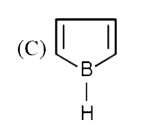Aromatic compounds are:




The correct Answer is:ABD
To determine which compounds are aromatic, we need to follow certain criteria. Let's break down the steps to analyze the given compounds based on the criteria for aromaticity.
1. Understand the Criteria for Aromaticity:
- The compound must follow Hückel's rule, which states that it should have 4n+2 π electrons, where n is a non-negative integer (0, 1, 2, ...).
- The compound must be cyclic (form a ring).
- The compound must be planar (all atoms in the same plane).
- The compound must have complete conjugation (p-orbitals must overlap).
2. Analyze Each Compound:
- Compound A:
- It has 6 π electrons (which fits n=1 in 4n+2).
- It is cyclic and planar.
- It has complete conjugation.
- Conclusion: Compound A is aromatic.
- Compound B:
- It has 6 π electrons (again fits n=1).
- It is cyclic and planar.
- The lone pair can participate in resonance, contributing to the π system.
- Conclusion: Compound B is aromatic.
- Compound C:
- It has 4 π electrons (which fits n=0 in 4n).
- It is cyclic but does not have complete conjugation.
- Conclusion: Compound C is anti-aromatic (not aromatic).
- Compound D:
- It has 6 π electrons (fits n=1).
- It is cyclic and planar.
- The negative charge does not participate in delocalization but does not affect the aromaticity as long as there are 6 π electrons and complete conjugation.
- Conclusion: Compound D is aromatic.
3. Final Summary:
- The aromatic compounds from the options are A, B, and D.
- Compound C is anti-aromatic.
Final Answer:
The aromatic compounds are A, B, and D.
---
- The compound must follow Hückel's rule, which states that it should have 4n+2 π electrons, where n is a non-negative integer (0, 1, 2, ...).
- The compound must be cyclic (form a ring).
- The compound must be planar (all atoms in the same plane).
- The compound must have complete conjugation (p-orbitals must overlap).
- Compound A:
- It has 6 π electrons (which fits n=1 in 4n+2).
- It is cyclic and planar.
- It has complete conjugation.
- Conclusion: Compound A is aromatic.
- It has 6 π electrons (again fits n=1).
- It is cyclic and planar.
- The lone pair can participate in resonance, contributing to the π system.
- Conclusion: Compound B is aromatic.
- It has 4 π electrons (which fits n=0 in 4n).
- It is cyclic but does not have complete conjugation.
- Conclusion: Compound C is anti-aromatic (not aromatic).
- It has 6 π electrons (fits n=1).
- It is cyclic and planar.
- The negative charge does not participate in delocalization but does not affect the aromaticity as long as there are 6 π electrons and complete conjugation.
- Conclusion: Compound D is aromatic.
- The aromatic compounds from the options are A, B, and D.
- Compound C is anti-aromatic.
The aromatic compounds are A, B, and D.
Topper's Solved these Questions
- GOCBOOK - MOTIONCHAPTER - GOCEXERCISE - Exercise - 3
44 Videos
- GOCBOOK - MOTIONCHAPTER - GOCEXERCISE - Exercise - 4 Level - I
13 Videos
- GOCBOOK - MOTIONCHAPTER - GOCEXERCISE - Exercise - 2 (Level - I)
31 Videos
- GASEOUS STATE BOOK - MOTIONCHAPTER - GASEOUS STATE EXERCISE - EXERCISE-4( LEVEL-II)
19 Videos
- GRIGNARD REAGENTBOOK - MOTIONCHAPTER - GRIGNARD REAGENTEXERCISE - EXERCISE-2
16 Videos
Similar Questions
Knowledge Check
Aromatic compounds have________.
Apleasant smellBunpleasant smellCno smellDsmell of rotten eggsNumber of Aromatic compounds –
 A1B4C3D2
A1B4C3D2Aromatic compounds burn with
Ablue flameBgreen flameCred flameDsooty flame
The aromatic compounds present as particulates are
View SolutionThe aromatic compounds present as particulates are
View SolutionThe aromatic compounds present as particulates are
View SolutionThe aromatic compounds present as particulates are
View SolutionWhich of the following are aromatic compounds ?

View Solution
